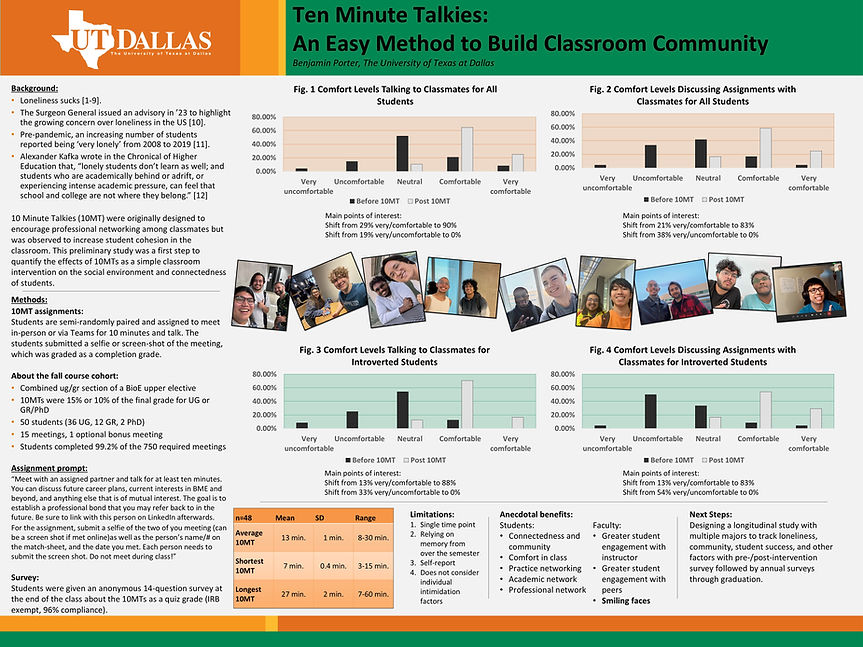Ten Minute Talkies: An Easy Method to Build Classroom Community
Social anxiety hampers many students from forming peer relationships. Assigning students to meet broke down social barriers in the classroom and led to networking.
Presented by:
Benjamin Porter, The University of Texas at Dallas

Abstract:
Lack of social connectivity can have serious consequences on a student’s ability to succeed in college. Although there are many causes associated with student loneliness, one factor is social anxiety about not knowing how to initiate conversation. A simple intervention in the way of a classroom assignment, Ten Minute Talkies (10MT), requiring students to meet with peers breaks down this initial barrier. A one-semester study using the 10MT in a class of 50 students found that the comfort ratings of students talking to each other tripled across all students and increased by a factor of seven for introverts.
Keywords:
Student Success, Classroom Community, Student Loneliness
Learning Outcomes:
1. Discuss the prevalence of student loneliness and the impact it has on resiliency and academic achievement.
2. Have a simple tool to use in the classroom for increasing social connectivity and building a classroom community.
3. Understand the limitations of the study and issues to avoid in their own implementation of an intervention.
Ten Minute Talkies: An Easy Method to Build Classroom Community

Hear it from the author:
Transcript:
This poster describes a simple intervention to build a more interactive classroom environment while helping students feel more connected to each other and network. Ten Minute Talkies were developed as a professional development assignment to encourage students to network with each other while gaining practice in holding conversations. Anecdotal feedback across several semesters was very positive, so, in fall of 2024, a survey was given as a preliminary step to designing a study to examine the effects of participating in the ten-minute talkies. Fifty students in a combined graduate level/upper undergraduate level course were randomly paired with different partners 15 times and required to talk outside of class for ten minutes about anything. Students submitted a selfie or screen shot of each meeting for a grade. Students reported meeting for an average of 13 minutes showing that they were mostly meeting for the whole time even though the times were not recorded (see the table). The surveys revealed the perceived discomfort of meeting with other students disappeared after just one ten-minute talkie with another student to the point that 90% of the students said they would be comfortable or very comfortable talking to a partner again (see figure 1). More encouragingly, the number of introverted students who said they would be uncomfortable or very uncomfortable discussing an assignment with their partner dropped from 54% to 0%, with 84% of introverts saying they would feel comfortable or very comfortable discussing an assignment with a partner after the ten-minute talkie assignment (see figure 4). While the results are encouraging, there are several limitations to the survey, including use of a single time-point and questions that were not from a validated assessment. However, the anecdotal benefits from the student survey included greater connectedness and community in the classroom, increased comfort with other students, the ability to practice networking, and the actual forming of a network. From an instructor's perspective, I noticed greater student engagement with myself and with their peers, and my grading of the assignments included looking at lots of pictures of smiling students who couldn’t help but smile when having their pictures taken. The next steps include forming a longitudinal study with multiple majors using validated survey questions that begin the start of the first semester and track through graduation.
References
Office of the Surgeon General (OSG). (2023). Our epidemic of loneliness and isolation: The U.S. Surgeon General’s advisory on the healing effects of social Connection and community. US Department of Health and Human Services. https://pubmed.ncbi.nlm.nih.gov/37792968/
Nicpon, E. F., Huser, L., Blanks, E. H., Sollenberger, S., Befort, C., & Kurpius, S. E. R. (2006). The relationship of loneliness and social support with college freshmen’s academic performance and persistence. Journal of College Student Retention Research Theory & Practice, 8(3), 345–358. https://doi.org/10.2190/a465-356m-7652-783r
Shin, E., Bui, K., & Park, J. H. (2024). Loneliness rates among undergraduates according to the National College Health Assessment from 2008 to 2019. Psi Chi Journal of Psychological Research, 29(3), 205–212. https://doi.org/10.24839/2325-7342.jn29.3.205
Guay, F., Boivin, M., & Hodges, E. V. E. (1999). Predicting change in academic achievement: A model of peer experiences and self-system processes. Journal of Educational Psychology, 91(1), 105–115, https://doi.org/0.1037/0022-0663.91.1.105